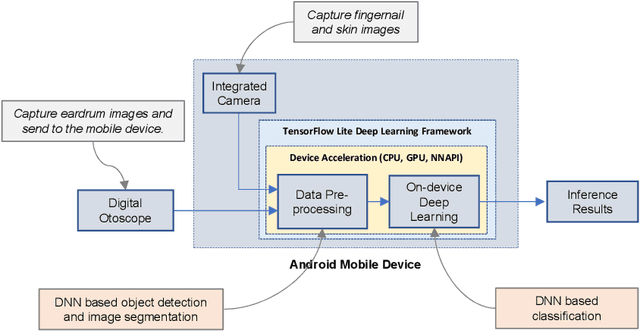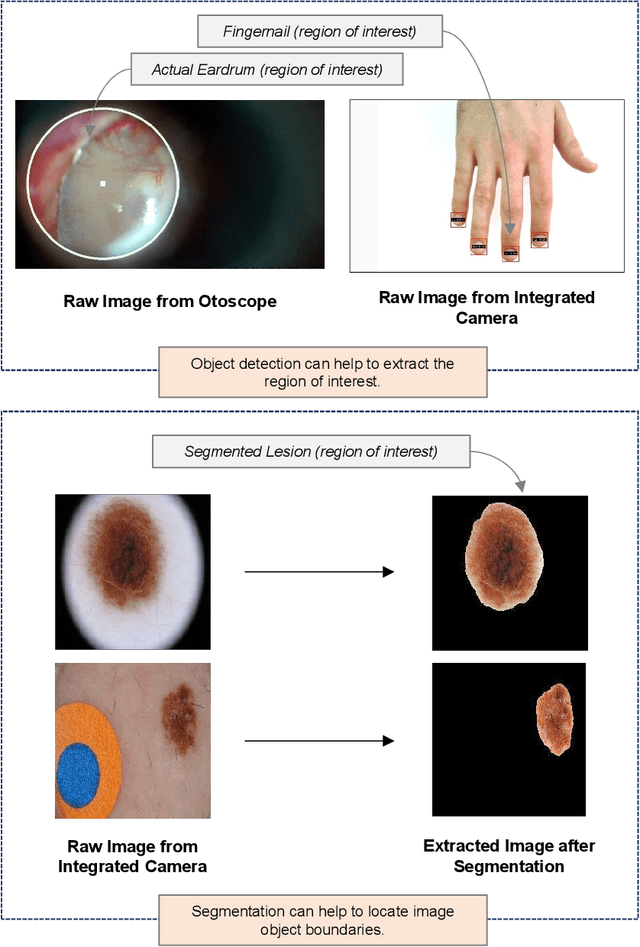Behnam Zeinali
Towards Implementing Energy-aware Data-driven Intelligence for Smart Health Applications on Mobile Platforms
Feb 01, 2023



Abstract:Recent breakthrough technological progressions of powerful mobile computing resources such as low-cost mobile GPUs along with cutting-edge, open-source software architectures have enabled high-performance deep learning on mobile platforms. These advancements have revolutionized the capabilities of today's mobile applications in different dimensions to perform data-driven intelligence locally, particularly for smart health applications. Unlike traditional machine learning (ML) architectures, modern on-device deep learning frameworks are proficient in utilizing computing resources in mobile platforms seamlessly, in terms of producing highly accurate results in less inference time. However, on the flip side, energy resources in a mobile device are typically limited. Hence, whenever a complex Deep Neural Network (DNN) architecture is fed into the on-device deep learning framework, while it achieves high prediction accuracy (and performance), it also urges huge energy demands during the runtime. Therefore, managing these resources efficiently within the spectrum of performance and energy efficiency is the newest challenge for any mobile application featuring data-driven intelligence beyond experimental evaluations. In this paper, first, we provide a timely review of recent advancements in on-device deep learning while empirically evaluating the performance metrics of current state-of-the-art ML architectures and conventional ML approaches with the emphasis given on energy characteristics by deploying them on a smart health application. With that, we are introducing a new framework through an energy-aware, adaptive model comprehension and realization (EAMCR) approach that can be utilized to make more robust and efficient inference decisions based on the available computing/energy resources in the mobile device during the runtime.
IMUNet: Efficient Regression Architecture for IMU Navigation and Positioning
Jul 29, 2022



Abstract:Data-driven based method for navigation and positioning has absorbed attention in recent years and it outperforms all its competitor methods in terms of accuracy and efficiency. This paper introduces a new architecture called IMUNet which is accurate and efficient for position estimation on edge device implementation receiving a sequence of raw IMU measurements. The architecture has been compared with one dimension version of the state-of-the-art CNN networks that have been introduced recently for edge device implementation in terms of accuracy and efficiency. Moreover, a new method for collecting a dataset using IMU sensors on cell phones and Google ARCore API has been proposed and a publicly available dataset has been recorded. A comprehensive evaluation using four different datasets as well as the proposed dataset and real device implementation has been done to prove the performance of the architecture. All the code in both Pytorch and Tensorflow framework as well as the Android application code have been shared to improve further research.
ESAI: Efficient Split Artificial Intelligence via Early Exiting Using Neural Architecture Search
Jun 21, 2021



Abstract:Recently, deep neural networks have been outperforming conventional machine learning algorithms in many computer vision-related tasks. However, it is not computationally acceptable to implement these models on mobile and IoT devices and the majority of devices are harnessing the cloud computing methodology in which outstanding deep learning models are responsible for analyzing the data on the server. This can bring the communication cost for the devices and make the whole system useless in those times where the communication is not available. In this paper, a new framework for deploying on IoT devices has been proposed which can take advantage of both the cloud and the on-device models by extracting the meta-information from each sample's classification result and evaluating the classification's performance for the necessity of sending the sample to the server. Experimental results show that only 40 percent of the test data should be sent to the server using this technique and the overall accuracy of the framework is 92 percent which improves the accuracy of both client and server models.
 Add to Chrome
Add to Chrome Add to Firefox
Add to Firefox Add to Edge
Add to Edge